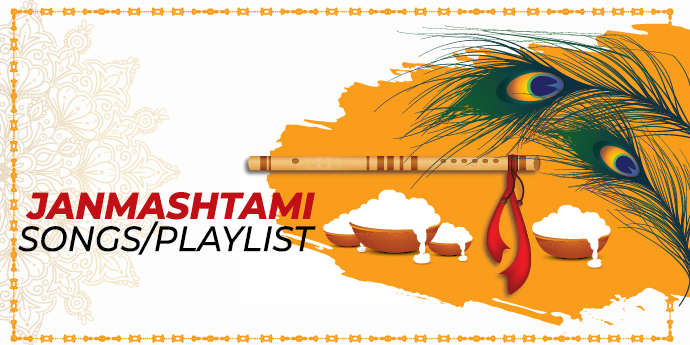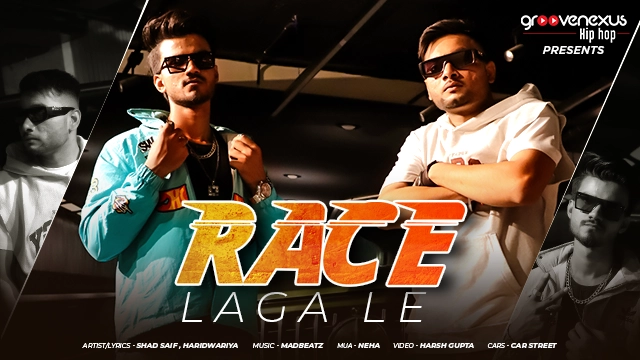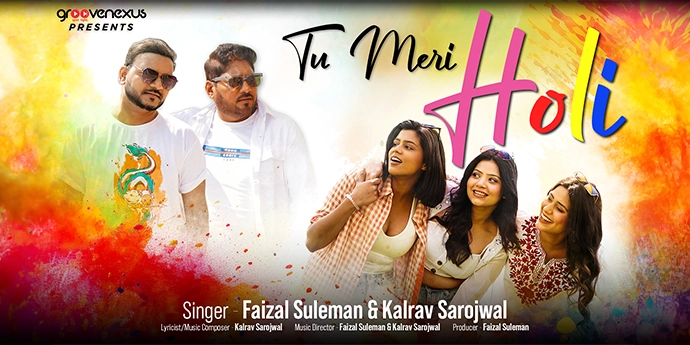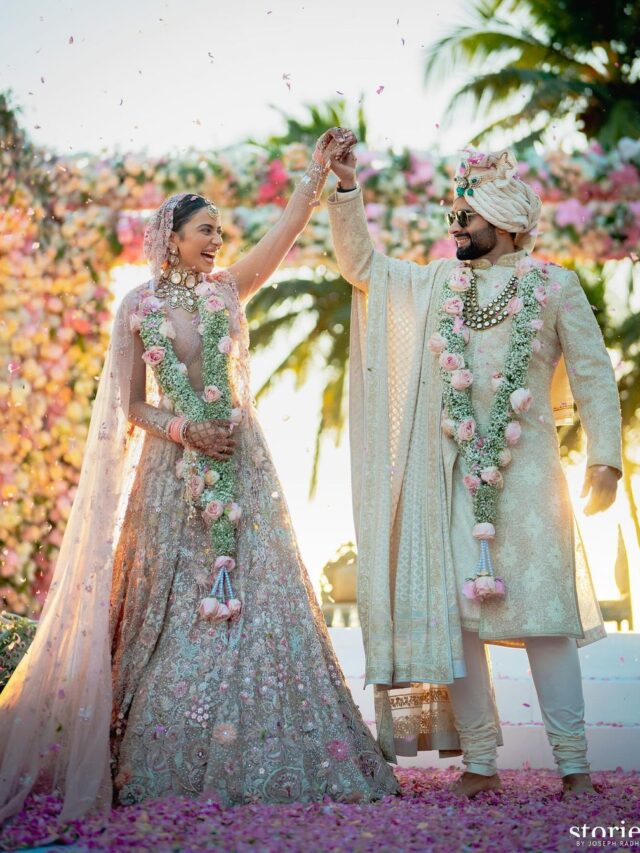In the heart of India’s rich tapestry of religious customs and festivities, Janmashtami shines as a radiant gem. Amidst the myriad of celebrations in the Hindu calendar, this festival stands tall as a favourite nationwide. It’s a time when devotion ignites the spirit, all in honour of the birth of Lord Krishna, the mischievous and mighty eighth avatar of Lord Vishnu. Enthusiasm bubbles over as people come together to celebrate, with Krishna Janmashtami songs in Hindi and Bollywood melodies dedicated to Lord Krishna adding to the festive charm. The air resonates with the soul-stirring melodies of Krishna Janmashtami bhajans, infusing a wave of positivity and fervour. In some corners, the streets become stages, where acts depicting the life and superpowers of Lord Krishna captivate the audience. Janmashtami is not just a festival; it’s a symphony of devotion, a dance of joy, and a celebration of Lord Krishna’s eternal love.

Table of Contents
During Krishna Janmashtami, you often hear the slogan ‘Haathi Ghoda Paalki, Jai Kanhaiya Lal Ki’ on the streets, showing Lord Krishna’s widespread appeal. This popularity is evident in Bollywood movies too, with many featuring scenes or songs related to Krishna Janmashtami.
When do we celebrate Krishna Janmashtami?
Krishna Janmashtami derives its meaning from Sanskrit: “janma” signifying birth and “ashtami” representing eight. It marks the celebration of Lord Krishna’s birth on the eighth day of the dark fortnight (Krishna Paksha) in the month of Bhadrapada (August–September).
GrooveNexus Special Krishna Janmashtami Songs Playlist
At GrooveNexus, we recognize the significance of this day. That’s why we’ve crafted an exclusive Janmashtami Songs Playlist. Dive into the enchanting tunes of Krishna Janmashtami Songs and relish precious moments with your loved ones.
Why do we celebrate Krishna Janmashtami?
Krishna Janmashtami is celebrated to honour the birth of Lord Krishna, who is a beloved deity in Hinduism. We celebrate it because Lord Krishna is seen as a symbol of love, wisdom, and righteousness. His life and teachings in the sacred text, the Bhagavad Gita, hold valuable lessons for humanity. This festival is a time to remember his divine presence and seek his blessings for a joyful and meaningful life. It’s also a time for people to come together, sing Krishna songs, and rejoice in the spiritual and cultural heritage he represents.
In this blog, we’ve gathered a variety of Krishna bhajan songs, ranging from the latest trends on YouTube and Instagram to timeless classics for Krishna Janmashtami. Our song list caters to all music enthusiasts and devoted followers of Lord Krishna, encompassing individual albums, movie tracks, TV series, and various streaming platforms. Lord Krishna’s timeless wisdom and charm have inspired people of all ages, making these songs a source of inspiration and devotion for everyone.
If you are also one of the Adherent Krishna believers and want to enjoy Janmashtami with full enthusiasm, you might not want to miss the Krishna Janmashtami song playlist created by us. Some of such Janmashtami songs are:
List of Famous Krishna Janmashtami Songs –
1. Shri Krishna Govind Hare Murari
Shri Krishna Govind Hare Murari
Hey Nath Narayan Vasudeva
Shri Krishna Govind Hare Murari
O Nath Narayan Vasudeva
“Shri Krishna Govind Hare Murari” is a divine musical offering presented by Gulshan Kumar and T-Series, showcasing the spiritual prowess of Bhushan Kumar. This enchanting composition features the mellifluous voice of Jubin Nautiyal, who skilfully brings to life the timeless verses. The musical tapestry is woven by the talented Raaj Aashoo, while the evocative lyrics are penned by Murali Agarwal.
This soul-soothing melody, “Shri Krishna Govind Hare Murari,” is a tranquil journey into the depths of devotion. It is designed to usher serenity into your busy mornings and mend your hearts. The music production, helmed by Anmol Daniel, ensures a seamless blend of melody and spirituality. The sound is expertly crafted by Vijay Dayal, making it a feast for the ears.
Let the melodic strains and heartfelt devotion of Jubin Nautiyal transport you to a realm of spiritual bliss.
2. Humare Saath Shree Raghunath Toh Kis Baat ki Chinta
Humare Saath Shri Raghunath To Kis Baat Ki Chinta
Sharan Me Rakh Diya Maath To Kis Baat Ki Chinta
Kiya Karte Ho Tum Din Raat Kyu Bin Baat Ki Chinta
Kiya Karte Ho Tum Din Raat Kyu Bin Baat Ki Chinta
“Humare Saath Shree Raghunath Toh Kis Baat Ki Chinta” is a captivating devotional masterpiece that resonates with the divine presence of Lord Raghunath, a revered form of Lord Rama. This enchanting composition is a melodious journey that beckons you into a realm of profound spiritual devotion and inner tranquillity.
The song is brought to life by heartfelt vocals and traditional musical instruments, creating an atmosphere of deep reverence and devotion. Its timeless lyrics carry a potent message of unwavering faith, reminding us that with Lord Raghunath as our companion, there is no room for worry or anxiety in our lives. It serves as a reminder of the eternal presence of the Lord in our lives, guiding us through every challenge and blessing us with peace and harmony.
Click on the provided link to experience the transcendental beauty of “Humare Saath Shree Raghunath Toh Kis Baat Ki Chinta.”
3. O Palan Haare
O palanhare, nirgun aur nyare
Tumare bin hamara kaunon nahee
Hamaree uljhan suljhao bhagwan,
Tumare bin hamara kaunon nahee
Tumhe hamaka ho sambhale,
tumhe hamare rakhwale
Tumare bin hamara kaunon nahee
“O Palanhare, Nirgun Aur Nyare” is a soul-stirring devotional song that beautifully encapsulates the essence of surrender and devotion. With heartfelt lyrics and a melodious tune, this song expresses deep reverence and reliance on the divine. It conveys the idea that the Lord is the ultimate refuge, the one who can untangle the complexities of life and provide solace in times of distress.
The repetitive refrain, “Tumare Bin Hamara Kaunon Nahee,” reinforces the belief that there is no one else who can guide and protect us like the Divine. It is an earnest plea to the Lord to come to our aid, to resolve our dilemmas, and to be our guardian.
The song carries a soothing and meditative quality, making it a perfect choice for moments of introspection and spiritual contemplation. Its serene melody and profound lyrics invite listeners to surrender their worries and place their trust in the caring hands of the Divine.
“O Palanhare, Nirgun Aur Nyare” is a timeless classic that continues to resonate with people seeking solace, guidance, and a deeper connection with their spiritual beliefs. It serves as a reminder that, ultimately, our true refuge lies in the loving embrace of the Divine.
4. Maiyya Yashoda Ye Tera Kanhaiya
Maiyya yashoda, yeh tera kanhaiya,
Panghat pe meri, pakde hai baiyan,
Tang mujhe karta hai, sang mere ladta hai,
Ramji ki kripa se, main bachi
“Maiyya Yashoda” is a delightful Hindi song from the 1999 movie “Hum Saath-Saath Hain: We Stand United.” This enchanting melody is brought to life by the melodious voices of Alka Yagnik, Anuradha Paudwal, and Kavita Krishnamurthy, who infuse the song with their incredible talent and heartfelt expression.
The song revolves around the playful and mischievous nature of Lord Krishna, endearingly referred to as “Kanhaiya.” The lyrics paint a vivid picture of the beloved Maiyya Yashoda, who lovingly chides Krishna for his playful antics by the village well, known as the “panghat.” Despite her efforts to scold him, Krishna’s charm prevails, and he continues to engage in playful banter.
The composition, crafted by the talented Raamlaxman (Vijay Patil), captures the joy and innocence of Krishna’s childhood, making it a heartwarming and uplifting musical experience. Dev Kohli’s lyrical prowess shines through, beautifully conveying the devotion and affection of Maiyya Yashoda towards her beloved Kanhaiya.
With its catchy tune and memorable lyrics, “Maiyya Yashoda” continues to be a beloved song that brings smiles to the faces of those who listen to it. It captures the essence of family, love, and the playful spirit of Lord Krishna, making it a cherished part of Indian musical heritage.
5. Yashomati Maiya Se Bole Nandlala
Yashomati Maiya Se Bole Nandlala
Yashomati Maiya Se Bole Nandlala
Radha Kyun Gori Main Kyun Kaala
Radha Kyun Gori Main Kyun Kala
“Yashomati Maiya Se Bole Nandlala” is a classic Hindi devotional song that beautifully encapsulates the playful and charming essence of Lord Krishna’s childhood. The song is a conversation between young Krishna, fondly referred to as “Nandlala,” and his mother Yashoda.
The lyrics of the song depict a light-hearted exchange between Krishna and his mother, where Krishna questions why his beloved Radha is fair-skinned (gori), while he himself is dark-skinned (kala). This playful interaction between mother and child is a beloved theme in Hindu mythology, symbolizing the innocence and endearing qualities of Krishna.
The song is not only a musical delight but also a cultural treasure, as it captures the essence of devotion and the loving bond between a mother and her child. The melody is both catchy and heartwarming, making it a favorite among music enthusiasts of all ages.
“Yashomati Maiya Se Bole Nandlala” has been sung by various artists over the years, each adding their unique touch to this timeless composition. It remains a popular choice for devotional performances, festivals, and celebrations, continuing to evoke feelings of joy and nostalgia.
6. Bada Natkhat Hai Re
Bada Natakhat Hai Re Krishna Kanhaiya
Ka Kare Yashoda Maiyya Haan
Bada Natakhat Hai Re
Dhoondhen Ree Akhiyaan Use Chahoo Or
Jaane Kahaan Chhup Gaya Nandakishor
“Bada Natakhat Hai Re Krishna Kanhaiya” is a lively and affectionate Hindi song that playfully portrays the mischievous nature of Lord Krishna, affectionately referred to as “Kanhaiya.” The song is a delightful conversation between Yashoda Maiyya, Krishna’s foster mother, and her beloved child.
The lyrics of the song describe Krishna as a mischievous and playful child who keeps Yashoda Maiyya on her toes. He is portrayed as a little troublemaker who constantly finds new ways to hide and evade his mother’s watchful eye. Yashoda Maiyya’s love for Krishna shines through as she tries to find him and bring him back from his playful escapades.
“Ka Kare Yashoda Maiyya Haan, Bada Natakhat Hai Re Krishna Kanhaiya” celebrates the innocence and charm of Lord Krishna’s childhood, a theme deeply cherished in Hindu mythology. It reminds us of the loving and playful bond between a mother and her child and the enduring love that exists between Krishna and his devotees.
7. Maiya Yashoda – Jamuna Mix
natkhat natkhat jamuna ke tatt par,
kuch to churaye haye maiyya
dil churaye neend churaye chain churaye haye maiyya
kaise main jaaun ghar apne sab laaj sharam main chhodi re
kaise kahun kis natkhat ne kiya maakhan chori re..
maiyya yashoda mori gagri se jamuna ke pul par maakhan haan koi, re maakhan chura le gaya
“Natkhat Natkhat Jamuna Ke Tatt Par” is a spirited and mischievous Hindi song that encapsulates the playful antics of Lord Krishna during his childhood. The song is a delightful portrayal of the beloved episode where young Krishna, also known as “Natkhat,” steals butter (maakhan) from the homes of the Gopis in the village of Vrindavan.
The lyrics vividly describe Krishna’s mischievous activities, as he playfully takes butter, causing laughter and joy among the village women. The phrase “Natkhat Natkhat” reflects Krishna’s charming and endearing nature, as he brings cheer and mischief to the lives of the villagers.
“Kaise Main Jaaun Ghar Apne Sab Laaj Sharam Main Chhodi Re” is a line that reflects the dilemma of the Gopis, who find it difficult to report Krishna’s mischief to their respective homes because they are too enamored by his charm.
“Maiyya Yashoda Mori Gagri Se Jamuna Ke Pul Par Maakhan Haan Koi, Re Maakhan Chura Le Gaya” narrates the story of Krishna, who, with his enchanting ways, manages to steal butter even from the most vigilant of Gopis.
This song is a musical tribute to the playful and endearing side of Lord Krishna’s childhood, capturing the essence of his divine pranks and the love and devotion of the people of Vrindavan. It continues to be cherished and performed in various cultural and devotional settings, bringing smiles and laughter to those who celebrate the joyous spirit of Krishna.
8. Wo Kisna HaiaiaHai
Jo Hai Albela Madnainowala
Jiski Deewani Brij Ki Har Bala
Woh Kisna Hai… (4)
Kisna Hai
( Jo Hai Albela… Ki Har Bala )
Woh Kisna Hai… (4)
( Pyar Mein Doobi, Pyar Mein Khoyi
Pyar Ki Dhun Mein Jaagi Na Soyi )… (2)
Duniya Se Hai Woh Anjaani
“Jo Hai Albela Madnainowala” is a melodious and enchanting Hindi song that celebrates the captivating charm of Lord Krishna, also known as “Kisna.” The song beautifully describes the irresistible allure and divine magnetism of Krishna, drawing devotees from all corners of the land.
The lyrics depict Krishna as the beloved deity of Vrindavan, with the Gopis being utterly enchanted and devoted to him. The term “Madnainowala” refers to Krishna, the one with captivating eyes that mesmerize anyone who gazes upon them.
The song’s verses convey the idea that Krishna is the ultimate object of affection and devotion for those who are deeply enamored by him. It describes the Gopis as his ardent admirers, willingly surrendering themselves to his enchanting presence.
The repeated refrain of “Woh Kisna Hai” emphasizes the central theme of the song, highlighting Krishna’s divine identity and the profound love that surrounds him. The melody, with its soothing and entrancing tune, complements the lyrics perfectly, creating a mesmerizing musical experience.
The lines “Pyar Mein Doobi, Pyar Mein Khoyi, Pyar Ki Dhun Mein Jaagi Na Soyi” celebrate the idea that Krishna’s love is so profound and captivating that it consumes the hearts and minds of those who adore him. The song captures the essence of devotion and the blissful surrender to the divine.
9. Radhe Radhe Radhe Barsaane Waali
Shree radhe radhe barsane wali radhe (x2)
Jai radhe radhe jai radhe radhe,
Brijbhan dulhari radhe radhe,
Bhakton ki pyari radhe radhe,
Ho shyama pyari radhe radhe,
Haridas dulari radhe radhe,
“Shree Radhe Radhe Barsane Wali Radhe” is a devotional song that beautifully celebrates the divine and enchanting presence of Radha, the beloved consort of Lord Krishna. This melodious composition is a heartfelt homage to the beloved goddess of love and devotion, Radhe, who is worshipped with great reverence in Hindu mythology.
The song opens with the repeated chanting of “Shree Radhe Radhe Barsane Wali Radhe,” which sets the tone for the entire piece. This powerful mantra is sung with deep devotion and fervour, invoking the presence of Radhe in the hearts of the listeners.
As the song progresses, it transitions into a jubilant chorus of “Jai Radhe Radhe Jai Radhe Radhe,” expressing the joy and adoration that devotees feel for Radhe. The repetition of “Jai Radhe Radhe” serves as a celebration of Radhe’s divine grace and her role as the epitome of love and devotion.
The verses of the song paint a vivid picture of Radhe as “Brijbhan Dulhari Radhe Radhe,” emphasizing her connection to the holy land of Brij, where Lord Krishna spent his childhood. Radhe is portrayed as the cherished daughter of Brijbhan, endearing her to the hearts of her devotees.
The lyrics continue to describe Radhe as “Bhakton Ki Pyari Radhe Radhe,” highlighting her status as the beloved of all devotees. This line signifies Radhe’s universal appeal and her ability to shower her love and blessings upon her devotees, regardless of their background or beliefs.
10. Aaarti Kunj Bihari Ki
Aarti Kunj Bihari Ki
Shri Girdhar Krishna Murari Ki॥ x2
Gale Mein Baijanti Mala,Bajave Murali Madhur Bala
Shravan Mein Kundal Jhalakala,Nand Ke Anand Nandlala
Gagan Sam Ang Kanti Kali,Radhika Chamak Rahi Aali
Latan Mein Thadhe Banamali
Bhramar Si Alak, Kasturi Tilak, Chandra Si Jhalak
Lalit Chavi Shyama Pyari Ki
Shri Girdhar Krishna Murari Ki
“Aarti Kunj Bihari Ki” is a devotional song that pays homage to Lord Krishna, the divine incarnation of Vishnu, who is known for his enchanting and divine presence. This timeless composition is a heartfelt expression of devotion and love for Lord Krishna.
The lyrics vividly describe Lord Krishna, adorned with a “Baijanti Mala” (a sacred necklace) around his neck, while he plays the enchanting melody of the “Murali” (flute). The imagery of Lord Krishna’s divine music and his captivating presence is beautifully depicted in these lines.
As the song continues, it mentions Lord Krishna’s “Kundal” (earrings) that glimmer and sway gracefully as he listens to the melodious music of his own flute. This imagery portrays Lord Krishna as a charming and divine figure, captivating the hearts of his devotees.
The verses also mention Lord Krishna’s radiant form, likening it to the dark monsoon clouds, with his beloved Radhika shining like lightning beside him. The reference to “Banamali” (Krishna, who holds a forest garland) highlights Lord Krishna’s iconic appearance with a peacock feather adorning his hair.
The song further compares Lord Krishna to a bumblebee (“Bhramar Si Alak”) and mentions the sacred “Kasturi Tilak” (a mark of musk on his forehead) and his face resembling the moon. These metaphors symbolize the divine and captivating qualities of Lord Krishna.
The song beautifully concludes by addressing Lord Krishna as “Shyama Pyari Ki” and “Shri Girdhar Krishna Murari Ki,” emphasizing his endearing and enchanting nature as well as his role as the divine protector and beloved of his devotees.
11. Govinda Aala Re
Govinda Aala Re Aala Zara Matki Sambhaal Brijbaala (x2)
Are Ek Do Tin Char Sang Paanch Chhah Saat Hai Gvala (x2)
Govinda Aala Re Aala Zara Matki Sambhaal Brijbaala
“Govinda Aala Re Aala Zara Matki Sambhaal Brijbaala” is an exuberant and lively song that captures the joy and enthusiasm of the traditional Indian festival of Dahi Handi. This song is a celebration of Lord Krishna’s mischievous and playful nature, as well as a tribute to the spirit of unity and camaraderie that the festival represents.
The song kicks off with the energetic refrain, “Govinda Aala Re Aala,” which translates to “Govinda has arrived.” This declaration sets the festive tone and signifies the arrival of Lord Krishna, who is often referred to as Govinda.
The lyrics continue with, “Zara Matki Sambhaal Brijbaala,” encouraging Brijbaala (the residents of Brij, where Lord Krishna spent his childhood) to be careful and hold the matki (clay pot) securely. This line refers to the central activity of the Dahi Handi festival, where young men form human pyramids to reach and break a hanging pot filled with curd, symbolizing Lord Krishna’s love for butter.
The following verses emphasize the spirit of togetherness and teamwork, as people come together to form human pyramids. “Are Ek Do Tin Char Sang Paanch Chhah Saat Hai Gvala” signifies the counting of individuals participating in the pyramid formation, highlighting the unity and cooperation required to reach the matki.
12. Radhe Krishna Ki Jyoti Alokik
Radhe krishna ki jyoti alaukik
Tino lok mein chhaaye rahi hai
Bhakti vivash ek prem pujaarin
Phir bhi deep jalaaye rahi hai
Krishna ko gokul se radhe ko
Krishna ko gokul se radhe ko
Barasaane se bulaaye rahi hai
“Radhe Krishna Ki Jyoti Alaukik” is a soul-stirring devotional song that radiates with the divine love and spiritual connection between Lord Krishna and Radha. This composition beautifully encapsulates the transcendent and otherworldly nature of their love.
The song begins by exalting the extraordinary nature of the divine light that emanates from Radha and Krishna: “Radhe Krishna Ki Jyoti Alaukik.” This light is described as spreading across all three realms, signifying its universal and all-encompassing presence. It symbolizes the divine love and grace that transcend the material world.
The lyrics then introduce a devoted worshiper who is passionately immersed in the love and worship of Radha and Krishna, despite being bound by the shackles of human existence: “Bhakti vivash ek prem pujaarin.” This portrayal highlights the profound devotion and unwavering love that devotees hold for the divine couple.
The song marvelously conveys the essence of devotion when it mentions that even though this devotee is overwhelmed by love, she continues to light the lamp of devotion: “Phir bhi deep jalaaye rahi hai.” This act of devotion, even in the face of overwhelming love, underscores the timeless dedication of true devotees.
The song beautifully describes the connection between Krishna and Radha, acknowledging Krishna’s origin in Gokul and Radha’s in Barsana: “Krishna ko Gokul se Radhe ko Barsaane se bulaaye rahi hai.” This line emphasizes the magnetic attraction between the divine lovers, which transcends time and place, drawing them together in an eternal dance of love.
13. Mohe Chhedo Na Nand Ke Lala
Mohe chhedo na nand ke lala
Ki main hi brij bala
Nahi main radha teri
Mohe chhedo na nand ke lala
“Mohe Chhedo Na Nand Ke Lala” is a soulful and emotionally charged song that delves into the eternal and poignant love story of Lord Krishna and Radha. It captures a moment of playful yet profound interaction between them, showcasing Radha’s devotion and Krishna’s charm.
The song opens with Radha addressing Lord Krishna affectionately as “Nand Ke Lala,” acknowledging his upbringing in Nandgaon. Radha playfully asserts her identity, expressing, “Ki main hi Brij Bala,” signifying her deep connection to the land of Brij, where their love blossomed. This line underscores Radha’s sense of self-assuredness and her claim to Krishna’s love.
However, Radha humbly clarifies that she is not Radha, despite the common belief that she is the embodiment of devotion and love: “Nahi main Radha teri.” This moment highlights Radha’s humility and her understanding of the divine essence of her love for Krishna.
The refrain, “Mohe Chhedo Na Nand Ke Lala,” captures the heart of the song, where Radha gently implores Krishna not to tease her or play pranks on her. This plea reflects the intimate and tender nature of their relationship, where Radha is both the devoted lover and the playful companion of Krishna.
14. Mach Gaya Shor Saari Nagri Re
Mach gaya shor saari nagari re, sari nagari re
Aayaa biraj kaa baka sambhaal teri gagari re
O aayaa biraj kaa baka sambhaal teri gagari re
Are mach gaya shor saari nagari re, sari nagari re
Aayaa biraj kaa baka sambhaal teri gagari re
O aayaa biraj kaa baka sambhaal teri gagari re
“Mach Gaya Shor Saari Nagari Re” is a vibrant and joyous song that encapsulates the exuberance and festivities of a traditional Indian celebration, particularly one involving Lord Krishna. This song portrays the arrival of Lord Krishna, often depicted as a mischievous and playful deity, who brings immense joy and excitement to the town.
The song kicks off with an electrifying chorus declaring that a tremendous uproar has engulfed the entire town: “Mach Gaya Shor Saari Nagari Re.” This line sets the stage for a lively and energetic celebration, where the townsfolk are eagerly awaiting the arrival of someone special.
The lyrics then introduce the central character, “Biraj Ka Baka,” referring to Lord Krishna, who is often associated with Vrindavan (Biraj) and known for his playful antics. He is described as coming to “sambhaal teri gagari re,” signifying his arrival to protect or take care of someone’s water pot. This imagery alludes to Lord Krishna’s playful nature, where he would often steal the water pots of the milkmaids (gopis) during his childhood.
The refrain repeats, emphasizing the commotion and excitement that Lord Krishna’s presence brings to the town. This repetition reinforces the sense of jubilation and merriment that permeates the song.
15. Yashoda Ka Nandlala
Yashoda ka nandlala, Brij ka ujala hai, Mere lal se to, Sara jag jhil milaye
Zu zu zu zu zu zu zu, Zu zu zu zu zu zu zu
Sote sote gehari neend Mein, munna kyu muskaye
Puchho mujhse main, Janu isko kya sapna aaye
Jug jug se ye lal hai apna, Har pal dekhe bas yahi sapna
Zu zu zu zu zu zu zu
“Yashoda Ka Nandlala” is a delightful and heartwarming song that celebrates the endearing childhood of Lord Krishna, the beloved deity in Hindu mythology. This song paints a vivid picture of the playful and enchanting nature of young Krishna as he brings immense joy to his foster mother, Yashoda, and to the entire world.
The song begins by beautifully describing Krishna as “Yashoda ka Nandlala” (Yashoda’s darling son) and “Brij ka ujala hai” (the radiance of Brij), highlighting his divine and luminous presence in the town of Brij, where he grew up. This imagery evokes the sense of awe and admiration that people feel for Krishna’s divine grace and charisma.
The lyrics express the belief that “Mere Lal se to Sara jag jhil milaye” (My beloved son makes the whole world come alive), underscoring the idea that Krishna’s presence brings vitality and vibrancy to the entire universe. This notion reflects the belief in Krishna as a source of universal joy and happiness.
The song further explores the idea of Krishna’s dreams during deep slumber. It ponders why the young child would smile in his sleep, inviting listeners to contemplate the mysteries of Krishna’s divine consciousness.
The lyrics then emphasize the eternal and personal connection that devotees feel with Krishna, highlighting the notion that he has been a cherished part of their lives through the ages. This sentiment is beautifully expressed in the lines, “Jug jug se ye lal hai apna, Har pal dekhe bas yahi sapna” (For ages, this beloved child has been ours; we see this dream in every moment).
16. Badi Der Bhai Nandlala
Bari der bhai nandalala
Teri rah take brijbala
Gwal bal ik ik se puchhe
kaha hai murli wala re.
Koi na jaye kunja gali mein
Tujha bin kaliya chunne ko
Taras rahe hai jamuna ke tat
Dhun murli ki sunane ko
Ab to daras dikhade natkhat
Kyon duvidha me dala re
“Bari Der Bhai Nandalala” is a soulful and longing song that expresses the deep yearning and devotion of the singer towards Lord Krishna, also known as Nandalala, who spent his childhood in the town of Nandgaon (Nandalala). This song beautifully captures the essence of a devotee’s longing to be in the divine presence of Krishna.
The song opens with a heartfelt plea, “Bari der bhai Nandalala,” signifying the speaker’s understanding that it has been a long wait to reunite with the beloved Lord. The use of “bhai” (brother) adds a personal and affectionate touch to the relationship between the devotee and Krishna. “Teri rah take Brijbala” conveys the determination to follow the path that Krishna has taken, just as the residents of Brij (Brijbala) did.
The lyrics reflect the curiosity and devotion of the Gwal bal (young cowherds), who are inquiring from each other about the whereabouts of the “murli wala” (the one who plays the flute). This line highlights the community’s shared love and devotion for Krishna and their eagerness to be in his presence.
The next verses express the longing of the devotee to enter the Kunja gali (lane in the grove) where Krishna resides. The imagery of “kaliya chunne ko” (to pluck blossoming flowers) signifies the deep desire to offer Krishna beautiful blooms as a symbol of love and devotion.
The lyrics culminate with an emotional plea to Lord Krishna, referred to as “natkhat” (playful), asking him to reveal himself and end the devotee’s inner conflict: “Ab to daras dikhade natkhat, kyon duvidha me dala re.” This line emphasizes the desire for a direct and divine encounter with Krishna to dispel any doubts or dilemmas.
17. Main Kehta Danke Ki Chhot Par
mai kahta danke ki chot par mai kahta danke ki chot par
dhayan se sunio lala hari hai hazar haath vala
vo din dayala hari hai hazar haath vala
vo din dayala hari hai hazar haath vala
kya kahna samrath sayi ka kya kahna samrath sayi ka
kya se kya kar dala hari hai hazar haath vala
vo din dayala hari hai hazar haath vala
kon batore kankar pathar kon batore kankar pathar
jab ho hath me hira jab ho hath me hira
kanchan sada rahega kanchan kanchan sada rahega kanchan
“Hari Hai Hazar Haath Wala” is a devotional song that celebrates the omnipotent and benevolent nature of Lord Krishna, also known as “Sayi” or “Hari.” The song is filled with reverence and awe for the boundless divine power and compassion of Lord Krishna.
The song begins with the proclamation, “Mai kahta danke ki chot par,” which means “I say with utmost conviction.” This phrase sets the tone for the song, highlighting the singer’s unwavering faith and belief in the divine nature of Lord Krishna.
The lyrics go on to emphasize that Lord Krishna is not just any ordinary deity but possesses a multitude of hands, symbolizing his omnipresence and boundless abilities. “Hari hai hazar haath vala” expresses the idea that Krishna is the master of a thousand hands, signifying his ability to extend his divine assistance and blessings to countless devotees simultaneously.
The repetition of “vo din dayala” reinforces the notion that Lord Krishna is the epitome of compassion and benevolence. “Vo din dayala” translates to “that day of grace,” highlighting the divine moments when Krishna bestows his blessings upon his devotees.
The lyrics then ponder the question, “Kya kahna samrath Sayi ka?” which means “What can one say about the omnipotent Lord?” This question underscores the limitless nature of Krishna’s power and the inability of words to fully describe his greatness.
18. Madhuban Mein Radhika
madhuban me radhika nache re, madhuban me radhika nache re
giradhar ki muraliya baje re, giradhar ki muraliya baje re
madhuban me radhika nache re
pag me ghunghar bandhke, aa aa, aa pag me ghunghar bandhke
ghunghata mukh par dar ke, nainan me kajara lagake re
madhuban me radhika nache re
“Madhuban Mein Radhika Nache Re” is a spirited and enchanting song that paints a vivid picture of the divine and joyous dance of Radhika (Radha), the beloved consort of Lord Krishna, in the idyllic groves of Madhuban. This song captures the essence of love, devotion, and the blissful presence of Radha and Krishna.
The song opens with the jubilant exclamation that Radhika is dancing in the gardens of Madhuban: “Madhuban me Radhika nache re.” This line immediately transports listeners to the enchanting world of Vrindavan, where the divine love between Radha and Krishna blossoms.
The lyrics continue by mentioning the melodious sound of Giradhar’s (Krishna’s) flute, symbolizing his presence and the enchantment of his music. “Giradhar ki muraliya baje re” signifies the divine connection between Radha and Krishna, where his flute music serves as a call to her heart, inspiring her dance.
The song vividly describes Radha’s attire and adornments. “Pag me ghunghar bandhke” alludes to the anklets with bells that Radha wears on her feet, creating a delightful jingling sound as she dances. “Ghunghata mukh par dar ke” suggests Radha’s modesty as she covers her face with a veil, adding an element of mystique and romance to the scene. “Nainan me kajara lagake” refers to the application of kohl in Radha’s eyes, enhancing her beauty and making her gaze even more captivating.
19. Shyam Teri Bansi
Shyaam teri bansi
Pukaare radha naam
Log kare mira ko
Yun hi badanaam…
“Shyaam Teri Bansi” is a poignant and soulful song that reflects the deep devotion and love of the singer, who addresses Lord Krishna, also referred to as Shyaam (the dark complexioned one). This composition explores themes of divine love, devotion, and the societal judgments faced by devotees like Mira Bai.
The song begins with a heartfelt declaration that “Shyaam teri bansi,” meaning that Lord Krishna resides in the heart and soul of the devotee. This line sets the spiritual tone of the song, emphasizing the intimate and personal connection between the devotee and the divine.
As the lyrics continue, they describe how Radha’s name is uttered with devotion and reverence: “Pukaare Radha naam.” This line highlights the centrality of Radha’s devotion to Krishna, as she is considered the epitome of devotion and selfless love.
The song then touches upon the societal response to this deep devotion, stating that “Log kare Mira ko yun hi badnaam.” This line conveys the idea that society often misunderstands and criticizes individuals like Mira Bai, who are deeply devoted to their faith and express their love for the divine openly.
20. O Kanha Ab Toh Murli Ki
O Kanha Ab Toh Murli Ki Madhur Suna Do Taan
O Kanha Ab Toh Murli Ki Madhur Suna Do Taan
Main Hoon Teri Prem Deewani Mujhko Tum Pehchaan
Madhur Suna Do Taan
O Kanha Ab Toh Murli Ki Madhur Suna Do Taan
“O Kanha Ab Toh Murli Ki Madhur Suna Do Taan” is a melodious and emotionally charged song that beautifully captures the essence of deep love and devotion for Lord Krishna, affectionately referred to as “Kanha.” The song is an earnest plea from a devotee to hear the sweet and enchanting tunes of Krishna’s flute, a symbol of his divine presence and grace.
The song opens with the heartfelt request, “O Kanha Ab Toh Murli Ki Madhur Suna Do Taan,” which translates to “O Kanha, now play the sweet melodies of your flute for me.” This line reflects the profound yearning of the devotee’s heart to experience the divine music that emanates from Krishna’s flute.
The lyrics emphasize the devotee’s identity as a “Prem Deewani,” signifying a passionate lover deeply devoted to Krishna. The devotee longs for recognition and connection, seeking to be known and acknowledged by the beloved deity.
“Madhur Suna Do Taan” serves as a recurring and emotionally charged refrain, underscoring the devotee’s ardent desire for Krishna to play the flute with utmost sweetness. The repetition of this plea heightens the emotional intensity of the song.
21. Mann Mohana
Mann Mohana aaa
mann mohanaaa
Kanha sunona aaa
Tum bin paun kaise chaina
Tarsu tumhi ko din rain
“Mann Mohana” is an emotionally charged and soul-stirring song that beautifully expresses the deep love and yearning of a devotee for Lord Krishna, often affectionately referred to as “Kanha.” This song serves as a heartfelt plea from the devotee to Lord Krishna, asking him to listen to their fervent prayers and bring solace to their restless heart.
The song begins with the melodic repetition of “Mann Mohanaaaa,” creating an enchanting and tranquil atmosphere. This phrase translates to “Enchanter of Hearts,” perfectly encapsulating Lord Krishna’s ability to captivate and mesmerize the hearts of his devotees with his divine charm.
As the lyrics unfold, the singer implores Lord Krishna to lend an ear to their sincere entreaty: “Kanha sunona aaa.” This line signifies the intense longing of the devotee to have their prayers heard by Krishna, highlighting the hope that their deepest desires will reach the divine.
The song conveys a sense of incompleteness and unrest in the absence of Krishna: “Tum bin paun kaise chaina.” This line underscores the notion that genuine peace and contentment can only be attained through the divine love and grace of Lord Krishna.
22. Kanhaiya Kanhaiya Pukara Krenge
Kanhaiya Kanhaiya Pukara Karenge,
Latao Mein Brij Ki Gujara Karenge,
Kahin to Milenge Vo Banke Bihari,
Unhi Ke Charan Chit Lagaya Karenge.
Kanhaiya Kanhaiya Pukara Karenge,
Latao Mein Brij Ki Gujara Karenge.
“Kanhaiya Kanhaiya Pukara Karenge” is a devotional song filled with deep reverence and love for Lord Krishna, affectionately known as “Kanhaiya.” The song expresses the heartfelt calling of devotees to their beloved deity, their dedication to a life centered around the enchanting region of Brij, and their unwavering faith in the eventual union with Lord Krishna.
The song commences with the resonant call, “Kanhaiya Kanhaiya Pukara Karenge,” which translates to “Kanhaiya, Kanhaiya, we shall call out to you.” This line establishes the central theme of devotion and the earnest desire of devotees to connect with Lord Krishna through their heartfelt prayers and chants.
The following lines, “Latao Mein Brij Ki Gujara Karenge,” signify the devotees’ aspiration to live their lives amidst the lush and beautiful landscapes of Brij, which is often associated with the region where Lord Krishna spent his childhood. This choice of location reflects their dedication to following the divine path and experiencing the sacred aura of Krishna’s birthplace.
The lyrics also express the deep yearning to meet Lord Krishna in the form of “Banke Bihari,” one of his revered names. The devotees express their desire to offer their unwavering devotion and place their thoughts and hearts at his divine lotus feet: “Unhi Ke Charan Chit Lagaya Karenge.”
23. Tum Prem Ho
Tum prem ho… Tum preet ho
Meri bansuri ka geet ho
Tum prem ho..Tum preet Ho..
Manmeet ho Radhe..Meri manmeet ho
“Tum Prem Ho, Tum Preet Ho” is a melodious and heartfelt song that celebrates the profound love and devotion of the singer for Radha, who is addressed as “Manmeet,” meaning the beloved of the heart. The song is an expression of the deep affection and spiritual connection between the devotee and the divine.
The song begins with the declaration, “Tum prem ho, Tum preet ho,” which translates to “You are love, you are affection.” This line sets the tone for the song, highlighting the central themes of love and devotion to Radha.
The lyrics beautifully describe Radha as the “geet” (melody) of the singer’s bansuri (flute). This imagery symbolizes Radha as the source of inspiration and the muse for the music of the devotee’s life. It portrays the idea that Radha’s love and presence fill every note and tune of their existence.
The song repeats the affectionate phrase, “Manmeet ho Radhe, Meri manmeet ho,” conveying the deep love and personal connection the devotee feels for Radha. Radha is not just a deity but a beloved companion of the heart, making the relationship intimate and profound.
24. Radha Rani Laage
Yamunaji To Kaadi Kaadi, Raadha Gori Gori (x2)
Vrindavan Mein Dhoom Machave, Barsane Ki Chori
Vraj Dhaam Raadhajuki, Vraj Dhaani Laage, Vraj Dhaani Laage
Mane Kaaro Kaaro, Yamunaji-no Paani Laage (2)
Mithe Ras Se Bharori, Raadha Raani Laage, Maha Raani Laage
Mane Kaaro Kaaro, Yamunaji-no Paani Laage (x2)
“Yamunaji To Kaadi Kaadi” is a vibrant and joyful folk song that celebrates the divine love and devotion of Lord Krishna and Radha, particularly in the context of the picturesque region of Vrindavan and Barsana. This song encapsulates the spirit of devotion, the exuberance of the devotees, and the blissful atmosphere of Krishna’s divine abode.
The song opens with the enchanting declaration that “Yamunaji To Kaadi Kaadi, Raadha Gori Gori,” signifying the beloved Radha’s fair complexion and the association of the Yamuna River with their divine love. This imagery evokes the beauty and purity of their love story.
The lyrics describe the lively atmosphere of Vrindavan and Barsana, where the devotees celebrate with great enthusiasm: “Vrindavan Mein Dhoom Machave, Barsane Ki Chori.” This line highlights the joyous festivities and playful activities associated with Lord Krishna’s childhood in Vrindavan and his interactions with the gopis, including Radha.
The song continues to emphasize the significance of Vraj Dhaam (the divine land of Vrindavan) and the profound connection it holds for devotees. “Vraj Dhaani Laage, Vraj Dhaani Laage” expresses the deep spiritual attachment and love that devotees feel for this sacred place.
The song also mentions the sweet taste of divine love and devotion: “Mithe Ras Se Bharori, Raadha Raani Laage, Maha Raani Laage.” This line conveys the idea that the love shared between Radha and Krishna is sweeter than any nectar and is deeply fulfilling.
25. Achyutam Keshavam
Achyutam Keshavam Krishna Damodaram
Rama Naraynam Janaki Vallabham
Kaun Kehta Hai Bhagvan aate Nahi
Tum meera ke jaise bulaate nahi
“Achyutam Keshavam Krishna Damodaram” is a devotional song that pays homage to the various divine forms and names of Lord Krishna. The song celebrates the multifaceted and divine nature of Lord Krishna, who is known by many names and attributes in Hindu mythology. It also challenges the notion that God doesn’t respond to his devotees by comparing him to the love and devotion of Meerabai.
The song begins with the invocation of different names and forms of Lord Krishna: “Achyutam Keshavam Krishna Damodaram, Rama Naraynam Janaki Vallabham.” Each name carries specific significance, highlighting the different roles and characteristics of Lord Krishna. For example, “Keshava” refers to Krishna’s beautiful hair, “Damodara” recalls an incident from his childhood when he was tied with a rope by his mother, and “Janaki Vallabham” associates him with Sita, the beloved wife of Lord Rama.
The song then challenges the common belief that God doesn’t respond to the calls of his devotees: “Kaun Kehta Hai Bhagvan Aate Nahi, Tum Meera Ke Jaise Bulaate Nahi.” This line draws a parallel between Lord Krishna’s divine interactions with Meerabai and the potential for similar divine connections with other devotees who call upon him with sincere love and devotion.
The composition encourages devotees to realize that their heartfelt prayers and devotion can establish a profound connection with the divine, just as Meerabai’s unwavering devotion did. It emphasizes the idea that God is accessible and responsive to those who approach him with love and devotion.
26. Madhurashtakam
adharam madhuram vadanam madhuram
nayanam madhuram hasitam madhuram
hridayam madhuram gamanam madhuram
madhur-adipater akhilam madhuram
“Adharam Madhuram” is a devotional song that extols the sweetness and divine beauty of Lord Krishna’s various aspects and attributes. The song beautifully portrays the multifaceted charm and allure of the beloved deity, focusing on different facets of his enchanting persona.
The song begins with the repetition of “madhuram,” which means “sweet” or “charming,” underscoring the central theme of Krishna’s sweetness. The lyrics describe various aspects of Lord Krishna’s divine form and personality:
“Adharam Madhuram” – His lips are sweet: This line highlights the sweetness of Krishna’s speech and the soothing effect of his words on his devotees.
“Vadanam Madhuram” – His face is sweet: This verse emphasizes the divine radiance and beauty of Krishna’s face, which captivates the hearts of his devotees.
“Nayanam Madhuram” – His eyes are sweet: The lyrics celebrate the enchanting and alluring gaze of Lord Krishna, which is said to be filled with love and compassion.
“Hasitam Madhuram” – His smile is sweet: Krishna’s playful and charming smile is a source of joy and happiness for his devotees.
“Hridayam Madhuram” – His heart is sweet: This verse portrays Krishna’s loving and compassionate heart, which is open to all who seek his grace.
“Gamanam Madhuram” – His gait is sweet: Krishna’s graceful and majestic walk is described as sweet, symbolizing his divine presence.
The song culminates with the affirmation that “Madhur-Adipater Akhilam Madhuram,” meaning that Lord Krishna, the origin of all sweetness, is sweetness incarnate in every aspect. This serves as a reminder of the all-encompassing divine love and charm of Krishna.
27. Radhika Gori Se, Biraj Ki Chhori Se
Radhika gori se, Biraj ki chhori se
Maiya karade mero byah
Umar teri chhoti hai, nazar teri khoti hai
Kaise karadu tero byah
“Radhika Gori Se, Biraj Ki Chhori Se” is a playful and lively folk song that carries a touch of humor while celebrating the divine love story of Radha and Krishna. The song portrays the endearing interactions between Radha, often described as “Radhika gori” (fair Radha), and Krishna, the charming cowherd.
The song humorously addresses the notion of marriage in the context of the eternal love between Radha and Krishna. It begins with the plea, “Maiya karade mero byah,” which translates to “Mother, arrange my marriage.” In this line, the singer humorously requests their mother to arrange their marriage, highlighting the unconventional nature of Radha and Krishna’s relationship, which is not bound by societal norms.
The lyrics humorously depict Radha’s concern about Krishna’s age: “Umar teri chhoti hai, nazar teri khoti hai,” meaning “You are too young, and your vision is questionable.” This line playfully teases Krishna about his age and actions, adding a lighthearted touch to the song.
The song captures the innocence and simplicity of their divine love, which transcends the boundaries of age, societal expectations, and physical appearances. Radha and Krishna’s love is celebrated as pure and eternal, and their interactions are portrayed with affection and humor.
28. Mann Basia
Mann basiya o kaanha, rang rasiya o kaanha
Pavan prabhaatee jag ko jagaatee, bhanvre bhee karte hai gunjan
Pankh pasaare ude pakheru, sinduree sinduree aangan
Mangal mangal bela mangal, saurabh saurabh saara bhuvan
Inn charno me phul chadhaane aayee teree raadha mohan
Mann basiya o kaanha, rang rasiya o kaanha
“Mann Basiya O Kanha, Rang Rasiya O Kanha” is a soulful and evocative devotional song that celebrates the divine love between Lord Krishna, affectionately referred to as “Kanha,” and his beloved Radha. The song paints a vivid and poetic picture of the idyllic surroundings and the deep spiritual connection between Radha and Krishna.
The song begins by addressing Lord Krishna with loving adjectives: “Mann basiya” (the one who resides in my heart) and “Rang rasiya” (the one who is adorned in beautiful colors). This sets the tone for the deep and passionate devotion expressed throughout the song.
The lyrics vividly describe the early morning scene: “Pavan prabhaatee jag ko jagaatee,” where the dawn awakens the world. It paints a picture of a serene and enchanting atmosphere filled with the sweet sounds of buzzing bees, symbolizing the beauty of nature.
The song continues to depict the imagery of a blossoming garden: “Pankh pasaare ude pakheru, sinduree sinduree aangan.” Here, the spreading wings of birds and the blooming flowers symbolize the vibrant and colorful environment where Radha and Krishna’s divine love flourishes.
As the song progresses, it exclaims the auspiciousness of the moment: “Mangal mangal bela mangal, saurabh saurabh saara bhuvan,” signifying the sacredness and blissfulness of this divine union between Radha and Krishna.
The lyrics conclude with the arrival of Radha to offer flowers at Krishna’s feet: “Inn charno me phul chadhaane aayee teree raadha mohan.” This moment represents Radha’s devotion and love for Krishna, as she seeks to offer her heart and soul at his divine feet.
29. Bhor Bhaye Panghat Pe
bhor bhaye panaghat pe mohe natakhat shyaam sataaye
mori chunariyaa lipati jaaye mai ka karun haay raam haay
bhor bhaye panaghat pe mohe natakhat shyaam sataaye
mori chunariyaa lipati jaaye mai ka karun haay raam haay
bhor bhaye panghat pe
“Bhor Bhaye Panghat Pe” is a timeless and soulful song that portrays the emotions and longing of Radha, the beloved of Lord Krishna, as she awaits his arrival at the riverbank (panghat) in the early morning. The song beautifully captures the essence of devotion, love, and the eternal yearning for union with the divine.
The song opens with the lines “Bhor bhaye panaghat pe, mohe natakhat Shyaam sataaye,” which translate to “As dawn breaks at the riverbank, mischievous Krishna teases me.” This line sets the scene for Radha’s anticipation and the playful interactions that define their divine love story.
The lyrics continue with “Mori chunariyaa lipati jaaye, mai ka karun haay Raam haay,” expressing Radha’s helplessness as her veil gets entangled while she awaits Krishna. The use of “Raam haay” conveys her longing and anguish in the absence of her beloved.
The song is characterized by its emotive and poignant melody, which evokes a sense of longing and devotion. It beautifully encapsulates the deep love between Radha and Krishna and the spiritual connection that devotees strive to attain in their own lives.
30. More Kanha Jo Aaye Palat Ke
more kanhaa jo aaye palat ke
abki holi main khelungi dat ke
more kanhaa jo aaye palat ke
abki holi main khelungi dat ke
“More Kanhaa Jo Aaye Palat Ke” is a spirited and joyous folk song that celebrates the playful and colorful festival of Holi, a Hindu festival known for its exuberant celebrations, vibrant colors, and the worship of Lord Krishna, often referred to as “Kanhaa” or “Krishna.” This song captures the excitement and anticipation of the festival and the devotees’ eagerness to engage in playful interactions with their beloved deity, Krishna.
The song opens with the declaration, “More Kanhaa Jo Aaye Palat Ke,” which translates to “My Krishna, when you come back,” signifying the devotee’s heartfelt longing for Krishna’s presence during the Holi festival.
The lyrics express the devotee’s determination to play Holi with Krishna with enthusiasm and devotion: “Abki Holi Main Khelungi Dat Ke.” This line conveys the devotee’s commitment to celebrating Holi with great zeal, using vibrant colors and playful gestures.









